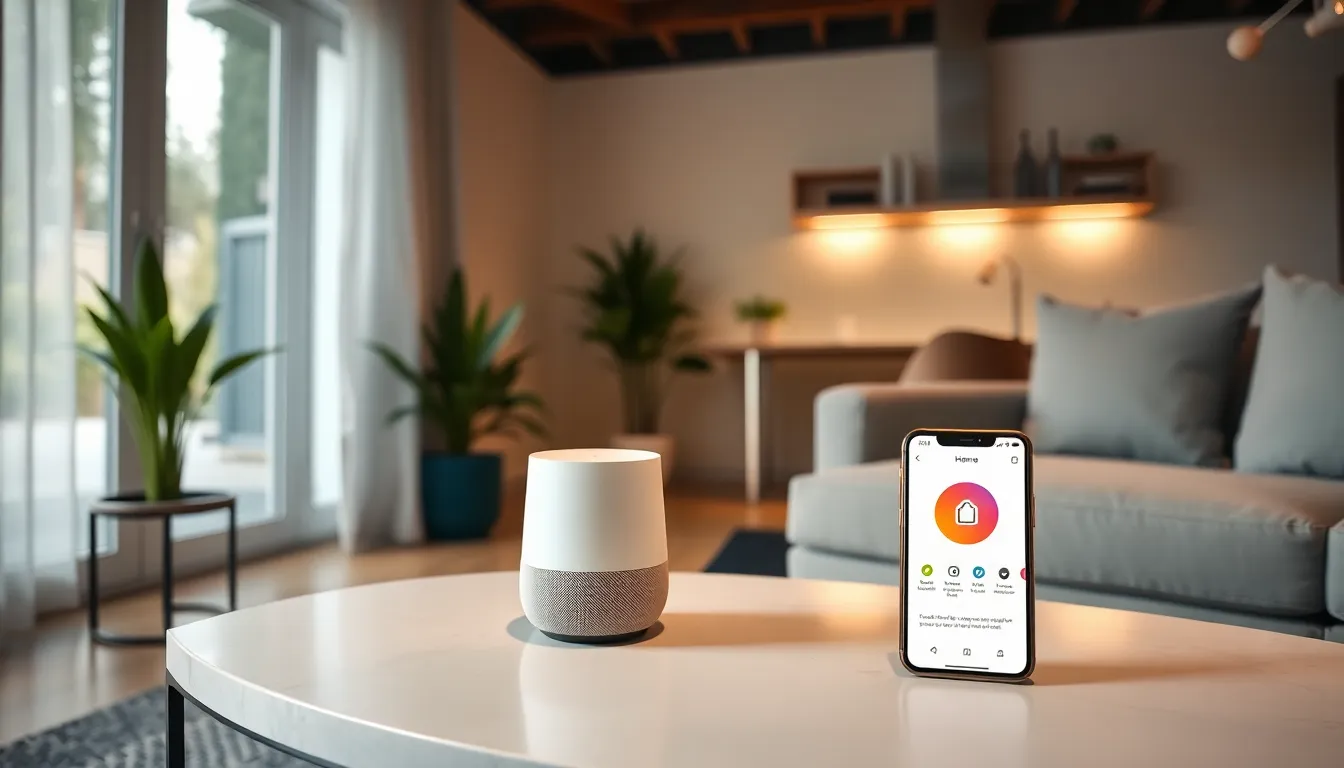Table of Contents
ToggleSetting up Google Home can feel like trying to solve a Rubik’s Cube blindfolded. With wires, apps, and voice commands flying around, it’s easy to wonder if this smart assistant is more trouble than it’s worth. But fear not! Once you get the hang of it, Google Home can turn your living space into a futuristic haven where asking for the weather is as easy as breathing.
Overview of Google Home Setup
Setting up Google Home involves several straightforward steps. First, users must download the Google Home app on their mobile devices. Then, they need to connect their smartphone to Wi-Fi. Next, they can open the app and follow the on-screen instructions to identify their Google Home device.
Upon finding the device, users can connect it to their Wi-Fi network by selecting the appropriate one and entering the password. After connecting, Google Home will download any necessary updates. These updates ensure the device operates with the latest features and improvements.
Once updates complete, users can customize their preferences, such as voice recognition and linked services. Additionally, integrating smart home devices enhances the functionality of Google Home. Compatible devices include smart bulbs, thermostats, and security cameras. Users can find setups for these devices within the same Google Home app.
Certain features, while optional, provide significant convenience. Setting up routines allows users to automate tasks like turning off lights or controlling the thermostat with simple commands. Voice command capabilities enable hands-free operation, allowing users to play music, check the weather, or get news updates effortlessly.
Compatibility also plays a key role in the setup process. Google Home works with various platforms, including Spotify, Netflix, and more. This compatibility enhances the user’s experience by creating an interconnected smart ecosystem.
Users should experiment with different features to find what works best for their daily routines. Engaging with Google Home through voice prompts not only creates a user-friendly interaction but also enriches the overall smart home experience.
Preparing for Google Home Installation

Setting up Google Home requires some essential devices and considerations to ensure a smooth process.
Required Devices and Accessories
Google Home relies on several key devices. First, a stable Wi-Fi network is crucial for connectivity. Next, users need a smartphone or tablet to download the Google Home app. Additionally, smart devices like lights or thermostats can enhance Google Home’s capabilities. Also, a compatible audio system enables access to music and media features. Optional accessories include Google Nest Hubs or speakers for expanded functionality. Each of these elements plays a role in creating an integrated smart home experience.
System Requirements
Certain system specifications must be met for optimal performance. A Wi-Fi connection requires compatibility with 2.4 GHz or 5 GHz bands. Android users need version 5.0 or higher, while iOS devices must run iOS 10.0 or later. It’s important to ensure the Google Home app is up to date for seamless interaction. User accounts must be linked to their Google account for access to features. Check that any smart devices to be integrated are compatible with Google Home as well. Meeting these requirements ensures a successful setup experience.
Step-by-Step Setup Process
Setting up Google Home may initially seem daunting. However, following these steps makes the process manageable and effective.
Downloading the Google Home App
Begin by locating the Google Home app in the App Store or Google Play Store. Install the app on a smartphone or tablet, as it’s essential for setup. The app takes less than a minute to download, depending on connection speed. Once installed, launch the app to initiate the setup process. Users must sign in with their Google account for seamless integration with other services.
Connecting to Wi-Fi
Ensure the smartphone or tablet connects to a stable Wi-Fi network. During setup, the Google Home app prompts users to select the correct Wi-Fi network. Users may enter the Wi-Fi password if prompted. After successful connection, the app confirms the device is online. This step ensures that Google Home can access the internet for commands and updates, enhancing overall functionality.
Configuring the Device
Next, the app guides users through device identification. Select the desired Google Home device from a list of nearby devices. Follow on-screen instructions to link the device to the Wi-Fi network established earlier. Updating software occurs automatically, ensuring the device runs the latest version. Customization options, such as voice recognition, allow users to tailor settings to individual preferences.
Troubleshooting Common Issues
Troubleshooting common Google Home issues can enhance the setup experience. Identifying and addressing specific problems makes for a smoother interaction.
Connection Problems
Network issues commonly affect Google Home’s performance. First, ensure the device is within range of the Wi-Fi router. A weak signal often leads to disconnection. Next, check the network credentials entered in the Google Home app for accuracy. Misentered passwords will cause connectivity problems. Restarting both the Google Home device and the router has proven effective in resolving many connectivity issues. Additionally, confirm the router is compatible with Google Home devices, particularly 2.4 GHz and 5 GHz bands. Sometimes, interference from other devices can disrupt the connection. Changing the router channel or relocating the device may help improve stability.
Voice Recognition Issues
Voice recognition problems can hinder functionality. Incorrect activation often stems from background noise or unclear speech. Users can minimize distractions by ensuring a quieter environment during interaction. Pronunciation and clarity play crucial roles; practicing commands can enhance recognition accuracy. Check the Google Home app settings to confirm that voice match is properly set up. Additionally, updating the app may resolve recognition problems due to software glitches. If the device fails to recognize common commands, a factory reset can restore original settings, potentially resolving deeper issues. Regularly speaking directly toward the device will also increase the chances of successful commands being executed.
Advanced Features and Customization
Google Home offers advanced features that enhance functionality and customization, allowing users to tailor their experience. Voice recognition settings enable individual profiles based on voice, allowing multiple users to access personalized information. Custom routines automate tasks, like dimming lights and playing music at specific times, streamlining daily activities.
Integration with compatible smart home devices expands capability. Users can control lights, thermostats, and appliances through simple voice commands. Device compatibility includes popular brands, creating an interconnected environment.
Setting up custom commands allows users to create shortcuts for frequently used phrases. For instance, a user can command, “Good morning,” to trigger multiple actions, such as adjusting the thermostat and providing a weather report. Custom responses can also enhance the interaction, making it feel more personal.
Using Google Assistant, users can add calendar events or set reminders, enhancing productivity through voice-activated assistance. The ability to link streaming services provides access to media controls, enabling music playback from platforms like Spotify or YouTube.
In addition, Google Home enables location-based reminders through the app. Location services allow reminders to trigger when arriving at specific places, proving useful for tasks like grocery shopping.
Experimenting with these advanced features leads to a more comprehensive understanding of Google Home’s potential. Engaging with different functions encourages users to explore possibilities, maximizing efficiency and convenience in everyday life. Voice prompts can create a more natural interaction, ensuring the smart home experience remains enjoyable and relevant.
Setting up Google Home may seem daunting at first but embracing the process can lead to a rewarding smart home experience. With a little patience and experimentation users can unlock the full potential of their device. From voice commands to automation routines Google Home transforms everyday tasks into effortless activities.
As users integrate their devices and customize settings they’ll discover new ways to enhance their living spaces. Troubleshooting common issues is part of the journey and knowing how to resolve them ensures a smoother experience. Ultimately Google Home stands as a powerful assistant that not only simplifies life but also adds a touch of innovation to any home.



